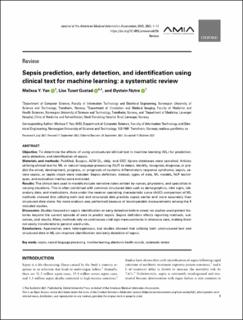| dc.description.abstract | Objective
To determine the effects of using unstructured clinical text in machine learning (ML) for prediction, early detection, and identification of sepsis.
Materials and methods
PubMed, Scopus, ACM DL, dblp, and IEEE Xplore databases were searched. Articles utilizing clinical text for ML or natural language processing (NLP) to detect, identify, recognize, diagnose, or predict the onset, development, progress, or prognosis of systemic inflammatory response syndrome, sepsis, severe sepsis, or septic shock were included. Sepsis definition, dataset, types of data, ML models, NLP techniques, and evaluation metrics were extracted.
Results
The clinical text used in models include narrative notes written by nurses, physicians, and specialists in varying situations. This is often combined with common structured data such as demographics, vital signs, laboratory data, and medications. Area under the receiver operating characteristic curve (AUC) comparison of ML methods showed that utilizing both text and structured data predicts sepsis earlier and more accurately than structured data alone. No meta-analysis was performed because of incomparable measurements among the 9 included studies.
Discussion
Studies focused on sepsis identification or early detection before onset; no studies used patient histories beyond the current episode of care to predict sepsis. Sepsis definition affects reporting methods, outcomes, and results. Many methods rely on continuous vital sign measurements in intensive care, making them not easily transferable to general ward units.
Conclusions
Approaches were heterogeneous, but studies showed that utilizing both unstructured text and structured data in ML can improve identification and early detection of sepsis. | en_US |

